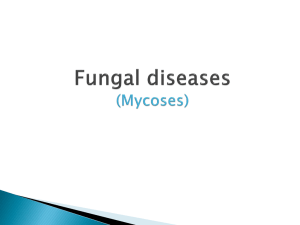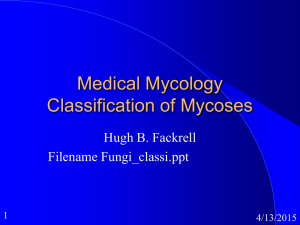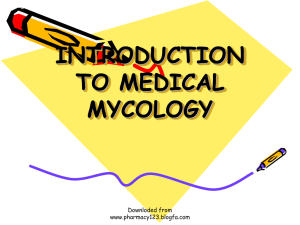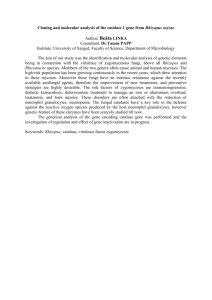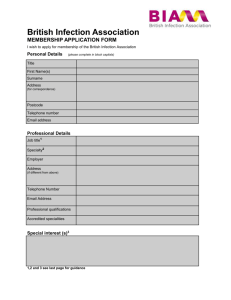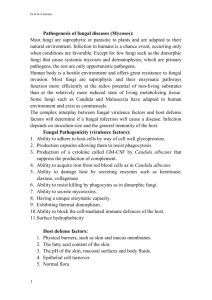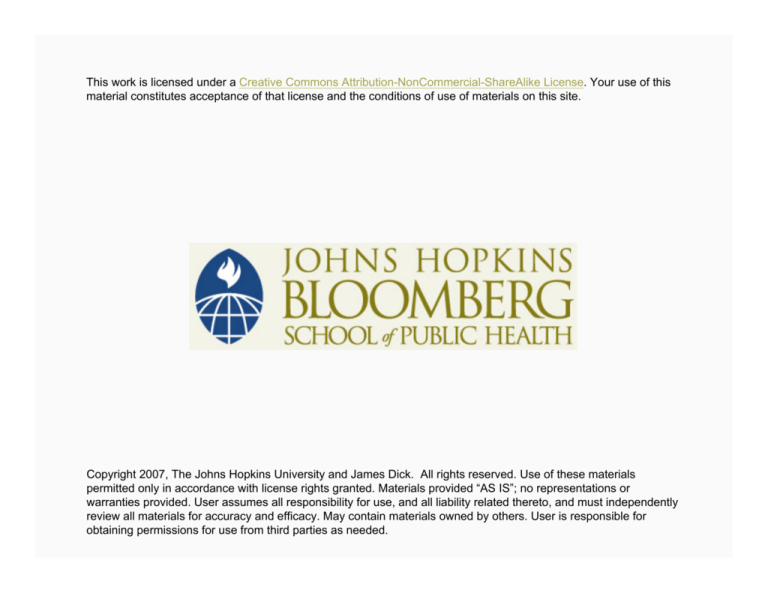
This work is licensed under a Creative Commons Attribution-NonCommercial-ShareAlike License. Your use of this
material constitutes acceptance of that license and the conditions of use of materials on this site.
Copyright 2007, The Johns Hopkins University and James Dick. All rights reserved. Use of these materials
permitted only in accordance with license rights granted. Materials provided “AS IS”; no representations or
warranties provided. User assumes all responsibility for use, and all liability related thereto, and must independently
review all materials for accuracy and efficacy. May contain materials owned by others. User is responsible for
obtaining permissions for use from third parties as needed.
Overview of Microbiology
James D. Dick, PhD
Johns Hopkins University
James D. Dick, PhD
Director, Bacteriology Section,
Division of Medical Microbiology
Associate Professor of Pathology,
Molecular Microbiology and Immunology
Researches biochemical and molecular
techniques for the detection and identification of bacterial pathogens and antibiotic resistance mechanisms
3
Section A
Overview of Microbiology
Classification of Infectious Disease
Clinical
− Major clinical manifestation
Epidemiological
− Transmission/reservoir
Microbiological
− Causative agent
5
Microbiological Classification of Infectious Disease
Viral
Bacterial
Fungal
Parasitic
Prions
6
Diagnosis of Infectious Diseases
Infection versus colonization
Disease versus exposure
Prevalence versus incidence
7
Comparison of Eukaryotic and Prokaryotic Cells
Characteristic
Eukaryotes
Prokaryotes
Form
Multicellular
Single cells
Nucleus
Nuclear membrane
DNA in contact with cytoplasm
Organelles
Membrane-bound organelles present
No organelles
Sterols
Always
Only in Mycoplasma
Ribosomes
80s = 40s + 60s
70s = 30s + 50s
Cell wall
Absent or cellulose/chitin
Peptidoglycan
Mitosis
Yes
No
8
Size Comparisons of Microorganisms
9
Bacterial Cell Structure
10
Bacterial Classification
Gram-positive
Gram-negative
Acid-fast
11
Bacterial Shapes
Cocci-round or spherical cells
Bacilli-rod-shaped cells
Curved, spiral forms
12
Biological Stains
Bacteria—gram stain
Fungi—KOH, lactophenol blue, India ink, silver stains in
tissue
Mycobacteria—acid fast stains
Parasites—trichrome stain, Wright’s stain
Viruses—antibody conjugated dyes
13
Spherical, Rod-Shaped, and Spiral
14
Bacterial Cell Walls
15
Pappenheim Stain of Streptococcus pyogenes
Public Domain
16
Dark Field Microscopy of Syphilis
Source: CDC
17
Classification of Viruses
Family
Example
Genome Size, Kilobases
of Kilobase Pairs
Envelope
RNA Viruses
Single-stranded
Picornaviridae
Poliovirus
7.2-8.4
No
Togaviridae
Rubella virus
12
Yes
Flaviviridae
Yellow fever virus
10
Yes
Coronaviridae
SARS
16-21
Yes
Rhabdoviridae
Rabies virus
13-16
Yes
Paramyxoviridae
Measles virus
16-20
Yes
Orthomyxoviridae
Influenza virus
14
Yes
Bunyaviridae
California encephalitis virus
13-21
Yes
Arenaviridae
Lymphocytic choriomeningitis virus
10-14
Yes
Retroviridae
HIV
319
Yes
Rotaviruses
16-27
No
Human parvovirus B-19
5
No
Hepatitis B
3
Yes
Polyomaviridae
JC virus
8
No
Adenoviridae
Human adenovirus
36-38
No
Herpesviridae
Herpes simplex virus
120-220
Yes
Poxviridae
Vaccinia, smallpox
130-280
Yes
Double-stranded
Reoviridae
DNA Viruses
Single-stranded
Parvoviridae
Partially double-stranded
Hepadnaviridae
Double-stranded
18
Viruses
19
Electron Micrograph of Viral Particle (Influenza)
Public Domain
20
Fluorescent Antibody Stain (Meningoencephalitis)
Public Domain
21
Characteristics of Fungi
Pathogenic fungi have two forms: yeasts (unicellular) and
molds (multicellular)
Some fungi are dimorphic
Molds grow as filamentous, branching strands of
connected cells known as hyphae
22
Characteristics of Fungi
Fungi classified by type/method of reproduction
Asexual—conidia; sexual—spores
“Micro” or “macro” refers to size of spores
23
Grouping of Fungi of Medical Importance
Superficial mycoses—outermost layers of skin and hair
Cutaneous mycoses—epidermis
Subcutaneous mycoses—dermis and subcutaneous
tissues
Systemic mycoses—internal organ systems
24
Fungi of Medical Importance
Fungus
Classification
Disease
Malassezia furfur
Yeast
Superficial mycoses
Trichophyton rubrum
Filamentous
Tinea, cutaneous mycoses
Microsporum audouinii
Filamentous
Tinea, cutaneous mycoses
Epidermophyton floccosum
Filamentous
Tinea, cutaneous mycoses
Candida albicans
Yeast
Mucocutaneous and systemic mycoses
Sporothrix schenckii
Dimorphic
Subcutaneous mycoses
Histoplasma capsulatum
Dimorphic
Systemic mycoses, histoplasmosis
Blastomyces dermatitidis
Dimorphic
Systemic mycoses, blastomycosis
Coccidioides immitis
Dimorphic
Systemic mycoses, coccidioidomycosis
Paracoccidioides brasiliensis
Dimorphic
Systemic mycoses, paracoccidioidomycosis
Penicillium marneffei
Dimorphic
Systemic mycoses, penicilliosis
Cryptococcus neoformans
Yeast
Systemic mycoses, opportunistic cryptococcosis
Candida species
Yeast
Opportunistic infections
Aspergillus fumigatus
Filamentous
Opportunistic infections
Aspergillus flavus
Filamentous
Opportunistic infections
Fusarium species
Filamentous
Opportunistic infections
Rhizopus species
Filamentous
Opportunistic infections
Mucor species
Filamentous
Opportunistic infections
Absidia species
Filamentous
Opportunistic infections
Pseudallesheria species
Filamentous
Opportunistic infections
Pneumocystis carinii
Dimorphic, cysts
Opportunistic infections
25
Histoplasma capsulatum
Public Domain
26
Medical Parasitology
Protozoa
− Amebiasis
− Leishmaniasis
− Trypanosomiasis
− Malaria
Helminths—adult stage in worm
27
Hookworm in stool
GNU Free Documentation License
28
Section B
Diagnostic Microbiology
Diagnostic Microbiology
Microscopy
Culture
Immunology
Molecular methods
30
Diagnostic Microbiology
Microscopy
− Light microscopy
− Fluorescence microscopy
− Electron microscopy
31
Bacteria
Staining characteristics
− Gram negative/gram positive
Shape
− Cocci-round or spherical cells
− Bacilli-rod-shaped cells
− Curved, spiral forms
− Coccobacilli
− Pleomorphic cells
Size
32
Microscopy
Sensitivity
− Relatively poor, one bacterial cell per high-powered
field is equivalent to 100,000–1,000,000 bacteria per
ml
− This can be improved through fluorescence
Specificity
− Poor for bacteria, high for microorganisms exhibiting
distinctive morphology—filamentous fungi, parasites,
viruses by EM
33
Diagnostic Microbiology
Culture
− Defined versus undefined media
− Enrichment media
− Selective media
− Specialized media
34
Blood Agar (Corynebacterium haemolyticum)
Public Domain
35
MacConkey's Agar (Proteus Vulgaris)
Public Domain
36
Culture
Sensitivity—usually considered the gold standard
Specificity—excellent when used in conjunction with
phenotypic, immunologic, and molecular techniques
37
Diagnostic Immunology
Testing for specific microbial antigens
− Direct detection from clinical specimens
− Characterization of a cultured organism
Testing for antibody to specific microbial antigens
− Detection of a particular isotope, usually IgM or IgG
− IgA and IgE not usually used
38
Diagnostic Immunology
Complement fixation
Agglutination assays
Neutralization/hemagglutination assays
Enzyme immunoassays (EIAs, ELISAs)
Radioimmunoassays (RIA)
Fluorescent antibody techniques
39
Fluorescent Antibody Stain (Neisseria gonorrhoeae)
Public Domain
40
Microbiology Tools for the Epidemiologist
41
Molecular Diagnostics
Nucleic acid probes
Signal amplification methods
− PCR
− RT-PCR
− Nested PCR
− Multiplex PCR
42
Sensitivity Comparisons of Molecular Methods
43
Probe Technology
Detection of fastidious, slow-growing, or nonculturable
organisms as well as antibiotic resistance genes and
phenotypically difficult organisms
44
Hybridization Techniques
Solid-phase
Liquid phase
In situ
45
Polymerase Chain Reaction (PCR)
46
Gel and Hybridizations of PCR Reactions
47
Limitations of Molecular Technology
False positive results
− Contamination
False negative results
− Presence of inhibitors
Narrow spectrum of detection
− Detection of a single pathogen
Cost
48

